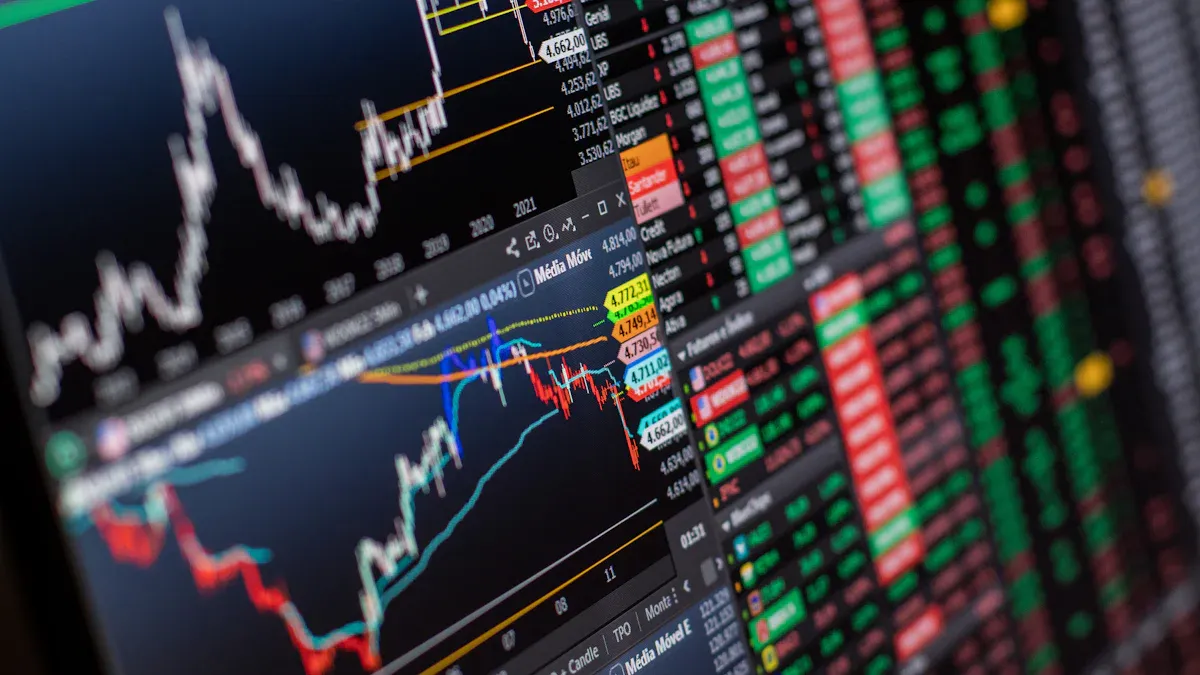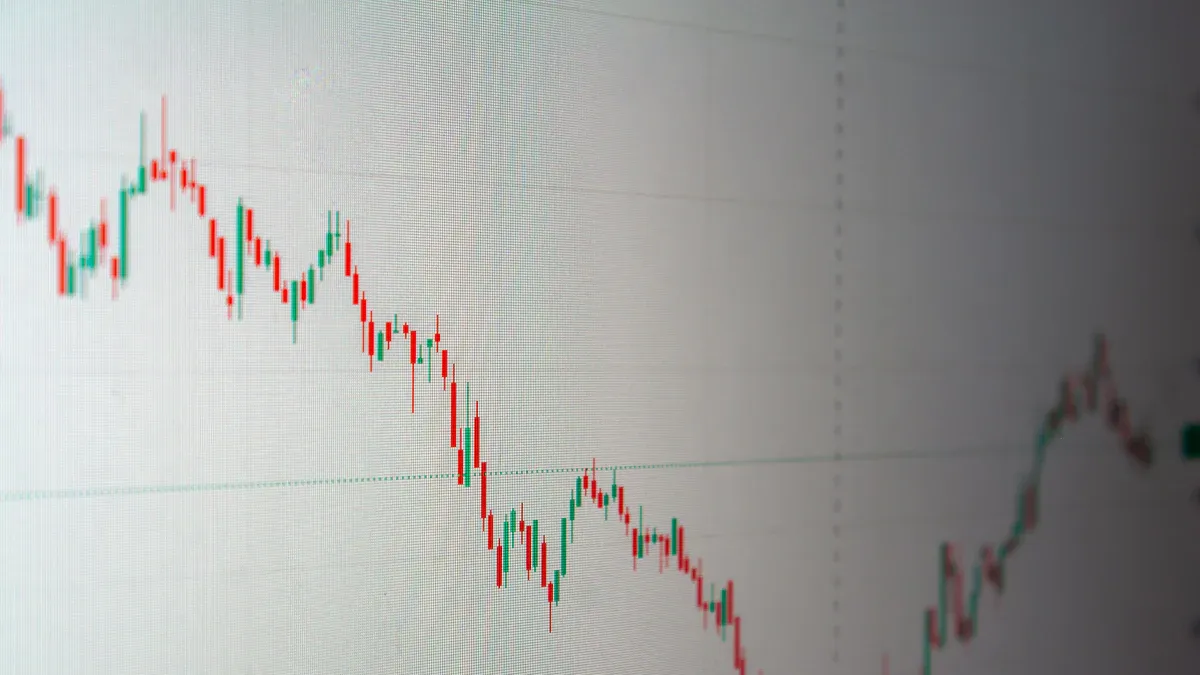- EasyCard
- Trade
- Help
- Announcement
- Academy
- SWIFT Code
- Iban Number
- Referral
- Customer Service
- Blog
- Creator
Meme Stocks Demystified: A High-Risk, High-Volatility Market Phenomenon Driven by Social Media

Image Source: pexels
You may notice that meme stock analysis reveals the significant impact of social media on markets. Discussions on social platforms cause investor sentiment to heat up rapidly during bull markets, driving price surges.
- Negative sentiment or viral posts on social media can lead to rapid sell-offs by investors, causing sharp stock price fluctuations.
- Young investors tend to view meme stocks as short-term profit tools rather than long-term holdings.
You need to consider why social media can cause certain stocks to skyrocket or plummet in the short term. What risks do you face when participating?
Key Takeaways
- Social media directly impacts meme stock price volatility, with changes in investor sentiment causing rapid price surges or declines.
- Meme stocks often lack fundamental support, and investors should rationally analyze a company’s financial health to avoid blindly following trends.
- Collective actions by retail investors on social media create feedback loops, driving sharp stock price fluctuations.
- When investing in meme stocks, identify risks and set clear investment goals and exit plans to protect investment safety.
- Stay rational, avoid impulsive decisions driven by social media hype, and focus on diverse information sources.
Meme Stock Analysis: Causes of High Risk and High Volatility

Image Source: unsplash
Social Media Influence
You will find that social media plays a critical role in meme stock analysis. Platforms like Reddit, Twitter, and TikTok enable information to spread extremely quickly. Investors can see the latest discussions and strategies within minutes.
Research shows that social media discussions, particularly on Twitter, directly influence meme stock trading volume and price volatility.
Online communities (such as Reddit’s WallStreetBets) drive coordinated buying and short squeezes by sharing opinions and strategies. Coordinated buying refers to a large number of investors collectively purchasing a stock in a short period, rapidly pushing up its price. A short squeeze occurs when heavily shorted stocks rise in price, forcing short sellers to repurchase shares at higher prices, further amplifying volatility.
You can refer to the table below to understand the correlation between social media activity and meme stock price surges:
| Study Title | Key Findings |
|---|---|
| Influence of Twitter social network graph topologies on traditional and meme stocks during the 2021 GameStop short squeeze | The study shows that dense network structures of social media activity are significantly correlated with the trading dynamics of specific meme stocks. |
| Social informedness and investor sentiment in the GameStop short squeeze | Social media sentiment amplified collective retail investor behavior during the short squeeze, serving as a predictor of price volatility. |
| Influence of Twitter social network graph topologies on traditional and meme stocks during the 2021 GameStop short squeeze | Significant increases in trading volume were linked to Twitter activity, indicating the unique impact of social media coverage on individual stock markets. |
Sentiment-Driven Behavior
You will notice during meme stock analysis that investor sentiment often dominates market trends. Retail investors’ emotionally driven behavior accounts for a significant portion of trading volume in small-cap stocks. Compared to institutional investors, retail investors are more susceptible to discussions and sentiment on social media.
- Consensus trading behavior among retail investors may lead to irrational decisions, increasing volatility in less liquid stocks.
- The correlated emotions of noise traders can alter the equilibrium price of stocks in the market.
- During the GameStop short squeeze, social media sentiment amplified collective retail investor behavior, serving as a predictor of price volatility.
You will find that rapid shifts in sentiment can lead to massive buying or selling by investors in a short period, further intensifying price fluctuations. This phenomenon is particularly prominent in meme stock analysis.
Retail Investor Collective Action
Meme stock analysis also requires attention to retail investors’ collective actions. Social media enables retail investors to quickly coordinate and share investment strategies. When a large number of investors collectively decide to buy a stock, its price surges sharply, creating a feedback loop that attracts more investors.
- Retail investors drive stock price increases on social media, particularly for heavily shorted stocks.
- For example, companies like Krispy Kreme and GoPro stood out in the latest meme stock rebound, reflecting retail trader participation.
- According to Goldman Sachs, the index of the most shorted stocks rose 13% this month, while the Russell 3000 index only increased by nearly 2%.
- Retail investor trading activity is particularly evident in the options market, especially in options trading related to meme stocks, where trading volume surges.
You can see that the influence of social media and retail investors’ collective actions together drive the sharp volatility of meme stocks. These fluctuations are often unrelated to the company’s actual business performance and are instead dominated by investor sentiment and community behavior.
Meme Stock Definition and Characteristics
Basic Concept
You will encounter the term “meme stock” in meme stock analysis. It refers to stocks that suddenly gain popularity due to discussions in online communities. You can refer to the table below to understand different institutions’ definitions of meme stocks:
| Source | Definition |
|---|---|
| Equals Money | Meme stocks are stocks that gain popularity due to humorous images or videos shared online, attracting attention from online communities and leading to surges in interest and trading activity. |
| Rotman School of Management | Meme stocks are stocks of companies that gain online attention and popularity on social media platforms. |
| Leeds University | Meme stocks are stocks that achieve viral popularity among a large number of investors through social media. |
You will find that the popularity of meme stocks is not driven by company performance but by online discussions and community attention.
Key Characteristics
Meme stocks differ significantly from traditional stocks. You can understand their differences through the table below:
| Characteristic | Meme Stocks | Traditional Stocks |
|---|---|---|
| Trading Volume | Typically low trading volume with high volatility driven by social media sentiment. | Stable trading volume influenced by news and company fundamentals. |
| Fundamentals | Weak fundamentals with little interest from large institutional investors. | Strong fundamentals with widespread attention from institutional investors. |
| Short Interest | High short interest, prone to short squeezes. | Low short interest, less susceptible to market manipulation. |
During meme stock analysis, you will find that investors often overlook fundamentals. They focus more on discussions and recommendations on social media. Many traders impulsively buy without conducting detailed market analysis or developing trading strategies. They hope to achieve quick returns through high-risk trades.
Role of Social Media
Social media plays a decisive role in the popularity of meme stocks. You can observe the following points:
- Meme stocks rapidly gain popularity due to social media discussions, with stock prices far exceeding their actual valuations, forming trading frenzies.
- In 2021, U.S. YouTuber Keith Gill drove GameStop’s stock price to $500 per share through social media, nearly 30 times its previous value.
- Social media platforms enable retail investors to collectively buy, amplifying market volatility.
- Many investors’ decisions are primarily based on social media recommendations rather than company fundamental analysis.
When participating in meme stocks, you need to be cautious of the significant impact of sentiment and community behavior on the market.
Typical Case Studies

Image Source: pexels
GameStop
You can learn about the typical case of GameStop through meme stock analysis. In 2024, several key events on social media directly drove sharp fluctuations in GameStop’s stock price. You can refer to the table below to understand the main events and stock performance:
| Event Date | Event Description | Stock Performance |
|---|---|---|
| June 3, 2024 | Keith Gill posted a screenshot on Reddit showing ownership of 5 million GameStop shares, valued at nearly $116 million USD. | The stock surged over 100% before the market opened, closing up 21%. |
| May 13, 2024 | Roaring Kitty posted for the first time on social media, sharing game-related images and videos. | The stock rose as much as 110% in early trading, closing up 74%. |
You will find that Keith Gill’s active behavior on Reddit and X platforms sparked investor interest. Discussions and sharing on social media led to a surge in GameStop’s trading volume, with its stock price skyrocketing in a short period.
AMC
You will also encounter the case of AMC during meme stock analysis. AMC’s stock gained attention from retail investors on platforms like Reddit and Twitter, resulting in significant price fluctuations.
- AMC’s stock surged over 400% in a short period due to social media activity.
- The r/WallStreetBets group’s collective actions made AMC a hot discussion topic.
- The #SaveAMC trend on social media sparked attention, causing the stock price to rise over 230% in a single day.
You can see that discussions and hashtag activity on social media directly influenced AMC’s stock performance.
Community-Driven Momentum
You will notice during meme stock analysis that community engagement is closely tied to stock price volatility.
- Reddit’s WallStreetBets community has become a key information source for retail investors, significantly impacting U.S. stocks and cryptocurrency markets.
- Studies show that increased community discussions correlate with heightened meme stock price volatility.
- Delays in social media information dissemination may lead to erroneous investor decisions, causing losses for many.
You need to monitor changes in community discussion intensity, as they directly affect meme stock trading volume and price. Under social media influence, investor sentiment is easily amplified, increasing market risks.
Market Risk Analysis
Short-Term Volatility
You will find during meme stock analysis that meme stocks experience extremely sharp short-term volatility. Driven by social media, rapid changes in investor sentiment lead to significant price fluctuations in a short period.
- During the early stages of the pandemic, both meme stocks and the S&P 500 exhibited significantly higher 20-day realized volatility.
- In January and May 2021, meme stock volatility spiked sharply, far exceeding market averages.
- The buy/sell ratio has fluctuated in recent months, with investors favoring call options.
You need to be cautious, as a shift in community sentiment can cause meme stock prices to plummet rapidly, resulting in significant investor losses. Changes in market sentiment, especially those driven by social media, often disconnect stock performance from company fundamentals.
Liquidity Risk
You will encounter liquidity risks when trading meme stocks. During intense trading activity, meme stocks’ liquidity risk manifests as increased volatility and rapid price changes.
- Liquidity may improve in the short term, but sudden sell-offs can exacerbate liquidity issues.
- Sentiment-driven trading challenges traditional market efficiency, with prices not necessarily reflecting company fundamentals.
You need to note that liquidity risks may prevent you from buying or selling at ideal prices during sharp market fluctuations, increasing investment uncertainty.
Neglect of Fundamentals
You will find during meme stock analysis that many investors often overlook company fundamentals.
- Many retail traders’ behavior is driven by emotions and cultural resonance, rather than company financial performance.
- Traded companies often perform poorly in terms of financial fundamentals and lack sustained shareholder engagement.
- For example, GameStop attracted significant investor attention despite facing liquidity crises.
You need to rationally analyze a company’s actual business and financial condition, avoiding investment decisions based solely on social media hype.
Meme Stock Analysis: Investment Recommendations
Risk Identification
During meme stock analysis, you must first learn to identify risks. Meme stock prices typically depend on investor sentiment, and social media hype may cause a stock to skyrocket temporarily but collapse rapidly when sentiment shifts. You may think you can “buy the dip,” but timing the market accurately is challenging.
Meme stocks are a high-risk asset class, prone to sharp and unpredictable fluctuations driven by rumors and online discussions. Many investors barely consider valuation models or company fundamentals, merely following social media trends.
You also need to watch for market liquidity risks. Meme stock trading volume may suddenly decrease, making it difficult to sell holdings at ideal prices.
Common risks include:
- Price performance relies on investor sentiment, prone to sharp rises and falls
- Market timing is hard to predict, making it easy to miss optimal buying or selling points
- Liquidity is not guaranteed, potentially trapping you in holdings
Before investing, you should analyze the company’s financial condition to determine if the stock price is reasonable. You can set a timeline for selling or sell in batches at target price points to reduce single-transaction risks. Develop a structured selling plan, incorporating a “minimize regret” mindset, and clearly define your risk tolerance.
Rational Response
You must stay rational during meme stock analysis. Social media hype can easily lead to impulsive decisions, but you need to conduct thorough research using reliable information sources. You can analyze company fundamentals, assess market trends, and avoid relying solely on a single social media platform’s opinions.
The Stressless Trading Method emphasizes discipline and structure, helping you avoid chasing hype cycles and focus on sustainable growth and stress-free investing.
You can adopt the following strategies:
- Diversify information sources to reduce bias
- Maintain skepticism and question investment advice on social media
- Stick to your investment strategy, avoiding impulsive decisions driven by short-term trends or market hype
- Develop a trading plan, control emotions, and set clear investment timelines
- Diversify holdings and determine the proportion of meme stocks in your portfolio based on your risk tolerance
You need to monitor social media discussions but avoid being swayed by emotions. You can periodically sell portions of your holdings at average prices to reduce single-point risks.
Avoiding Herd Mentality
During meme stock analysis, you must beware of herd mentality. Collective actions on social media can create “fear of missing out,” leading you to blindly follow others’ buying decisions. You may be influenced by anchoring and adjustment bias, resulting in misjudgments of stock value.
Speculative investments are often driven by social media hype, not company fundamentals. Many investors suffer significant losses after bubbles burst, while those avoiding herd speculation are more likely to achieve stable long-term returns.
You also need to guard against overconfidence bias, avoiding overestimating your abilities, which can lead to excessive trading and concentrated holdings.
You can refer to the following data:
| Stock | Peak Price (USD) | Current Price (USD) |
|---|---|---|
| GameStop | 120 | 23 |
| AMC | 445 | 3 |
You can see that the short-term surges of meme stocks do not guarantee long-term gains. You should stick to rational investing, align with your risk tolerance, scientifically allocate assets, and avoid blindly following trends.
You can see that meme stocks are essentially high-risk investments driven by social media. Social platforms accelerate information dissemination, amplify market sentiment, and cause sharp price fluctuations. You need to analyze rationally and avoid emotional decisions. Many investors learn risk management after experiencing volatility. You should align with your financial goals and risk tolerance, scientifically assess potential losses, and develop a clear exit plan to better protect your investment safety.
FAQ
What are meme stocks?
You can understand meme stocks as stocks that suddenly gain popularity due to social media discussions. Their price fluctuations are typically unrelated to the company’s actual business.
What are the main risks of investing in meme stocks?
You face sharp price volatility and liquidity risks. Changes in social media sentiment can cause stock prices to surge or plummet in a short period.
How does social media influence meme stock prices?
The discussions you see on social platforms rapidly affect investor sentiment. Collective buying or selling by large groups of users drives sharp price movements.
What should you consider when investing in meme stocks?
You need to rationally analyze company fundamentals. Avoid blindly following social media trends. It’s recommended to set clear investment goals and exit plans.
You now have a deep understanding of meme stocks’ high-risk nature: prices are driven by social media sentiment, not fundamentals. When engaging in this volatile market, you must have exceptional capital efficiency and cost control to lock in profits and mitigate risks during sharp swings.
Traditional cross-border trading methods—like high remittance fees and non-transparent exchange rates—can become a hidden burden on your short-term trading strategy. You need a global fund management platform that helps you optimize costs and respond quickly to market changes.
BiyaPay is your solution for high-efficiency trading. We offer real-time exchange rate inquiry and conversion for fiat currencies, with remittance fees as low as 0.5%. Crucially, our zero commission for contract limit orders dramatically cuts your transactional friction. BiyaPay supports the conversion between various fiat and cryptocurrencies, allowing you to participate in global market trading, including Stocks, all on one platform. There is no need for a complex overseas account, and you can enjoy same-day remittance and arrival. Click the Real-time Exchange Rate Inquiry now, BiyaPay for quick registration, and empower your high-risk trading strategy with superior capital efficiency!
*This article is provided for general information purposes and does not constitute legal, tax or other professional advice from BiyaPay or its subsidiaries and its affiliates, and it is not intended as a substitute for obtaining advice from a financial advisor or any other professional.
We make no representations, warranties or warranties, express or implied, as to the accuracy, completeness or timeliness of the contents of this publication.




Contact Us
Company and Team
BiyaPay Products
Customer Services
is a broker-dealer registered with the U.S. Securities and Exchange Commission (SEC) (No.: 802-127417), member of the Financial Industry Regulatory Authority (FINRA) (CRD: 325027), member of the Securities Investor Protection Corporation (SIPC), and regulated by FINRA and SEC.
registered with the US Financial Crimes Enforcement Network (FinCEN), as a Money Services Business (MSB), registration number: 31000218637349, and regulated by FinCEN.
registered as Financial Service Provider (FSP number: FSP1007221) in New Zealand, and is a member of the Financial Dispute Resolution Scheme, a New Zealand independent dispute resolution service provider.




















